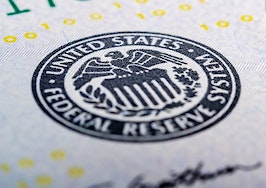- The Fed completed its meeting on Wednesday in some disarray.
- Chair Yellen expressed deep worry about job-market overheating.
- A 0.25 percent hike is coming in December, another 0.50 percent in 2017, and another 0.75 percent in 2018.
The important developments involving this week’s Fed meeting first, the how and why later: August was a lousy U.S. economic month, and long-term rates are back down, mortgages on the low side of 3.50 percent, and the 10-year T-note at 1.61 percent, its lowest since September 8.
Completing a clean sweep of August data, the entire housing series arrived this week below forecast. New permits, starts, sales of existing homes…all womp-womp.
The meeting
The Fed completed its meeting on Wednesday in some disarray, but different from apparent disarray. The Federal Open Market Committee voted to leave the overnight cost of money as-is, 0.25 percent to 0.50 percent — but three voters dissented, demanding a hike. That’s the first three-vote dissent since 2014 (the dissenters wrong then, too).
One window into the Fed is wide open: a schism between hawkish and narrow presidents of the twelve regional Feds and the Congressionally confirmed governors.
Three regionals annually rotate into FOMC voting status. At Wednesday’s meeting all three dissented. (A fourth regional, the New York Fed president, always votes but historically defers to the Chair).
The regionals are elected by local boards, which have self-perpetuating politics, few with any business anywhere near a central bank.
One dissenter was Esther George of the KC Fed — her 19-year predecessor, Tom Hoenig now safely embalmed at the FDIC. The KC Fed is always in favor of rate hikes and oblivious to its constant error.
Another: Loretta Mester, Cleveland, her published work emphasizing her accomplishments in math, her fondness for the first-person singular and non-discovery of economics outside the U.S. — or, perhaps, Ohio.
Chair Yellen expressed deep worry about job-market overheating, acknowledged below-target inflation but simultaneously insisted on an improving economy. She is doing as well as anyone could in a murky situation without precedent.
The new “damned little dot” scattergram below says a 0.25 percent hike is coming in December, another 0.50 percent in 2017, and another 0.75 percent in 2018 — to about 2.00 percent, half the level projected for 2018 in scattergrams two years ago.
The important part is the effect on long-term rates, and markets remain in total disbelief in the Fed’s ability to harm to bonds or mortgages.
Markets dismiss the inflation threat, job-market “Wolf! cried to Fed discredit; and markets believe that any significant hiking will quickly reverse, global events dwarfing U.S. concern.
The world
The Bank of Japan (BOJ) met the same day as the Fed, and supported the market view in every way. Negative rates have been a disaster, so the BOJ committed to holding Japan’s 10-year at 0.0 percent.
The BOJ simultaneously promised to continued purchase of Japan’s government debt (presumably short-term) at 80 trillion yen per month. Given the yen exchange rate at 101/$, easily converted to $80 billion per month, $960 billion per year.
The U.S. economy is 4.5 times the size of Japan’s; so for quantitative easing equivalence, imagine the Fed buying $4.3 trillion in Treasurys each year.
Oh, by the way: the BOJ will continue until “inflation exceeds the target of 2.0 percent and stays above the target.”
If Japan is going to peg its 10s at 0.0 percent, it’s going to peg everyone’s 10s in relation. As a monetary matter, Japan is a sieve, yen pouring out of the place into other bond markets, $300 billion last year.
A story like the above enrages Wall Street investment salespeople. How dare you central banks control everything? If markets have no meaning, how are we to trade? At least we can blame our poor performance on you.
Get over all of that. The central banks are not going to let the global economy crash. And never doubt that it would crash if central banks withdrew, or went passive. The U.S. alone has a recovery of sorts, and the Fed is antsy that global conditions won’t let it tighten as tradition would have it (also perhaps traditionally mistaken).
Maybe the central banks are just deferring an ultimate nuclear event, potential size growing every day. Much more likely: We will continue open-ended as we are, grappling with unintended consequences good and poor while global peoples and governments adapt to a new, non-normal era.

The location of the Fed funds rate at the end of each year ahead
Damned little dots, the location of the Fed funds rate at the end of each year ahead. One dot per governor and regional president. Thus throw out the top six dots, cast by regional bird-brains.
Anybody can be mistaken, but most people would adapt after the third or fourth or fifth or sixth year of error. For the forecast of the others to be correct, the outside world will need to heal a great deal.
BTW: the one ultra-low dot is self-confessed Bullard of St. Louis, too cute by half.

U.S. 10-year T-note in the last year.
U.S. 10-year T-note in the last year.

Fed-sensitive 2-year T-note also in the last year.
Fed-sensitive 2-year T-note also in the last year. These traders don’t even buy a December hike.

Crude global steel production
China is at the heart of a deflationary world, exporting its products, unemployment, and low wages. Total global steel capacity is almost double global demand, and China built 90 percent of its production capacity in just the last 15 years.
Its promises notwithstanding, it is building more capacity. China’s internal demand is about 650mt, bloated by non-productive investment, but 130mt below internal capacity.
The next three charts illustrate forecasting hell.

A three-month moving average indicator of the whole U.S. economy.
This first one is from the Chicago Fed, CFNAI-MA3 — a three-month moving average indicator of the whole U.S. economy. The 2014 peak is clear. The current chart value is the average of June (+0.9), July (+0.24), and August (minus .55), the two-year deceleration headed down again.

The Atlanta Fed tracker
The Atlanta Fed tracker has been remarkably accurate, but early hopes are fading for a third-quarter rebound to 3.5 percent growth or above. Much more likely: the tracker has yet to include fully the August nose-dive. We won’t have September stats for another two weeks.

ECRI Weekly Leading Index Growth
Then the ECRI (Economic Cycle Research Institute), one of the most-reliable, longest-running forecasters. See left-hand gross domestic product (GDP) scale. The ECRI has the U.S. in a screaming expansion approaching 5 percent annual.
Try to rationalize these three high-quality reports, and you get an idea what life is like for Chair Yellen.
Lou Barnes is a mortgage broker based in Boulder, Colorado. He can be reached at lbarnes@pmglending.com.












